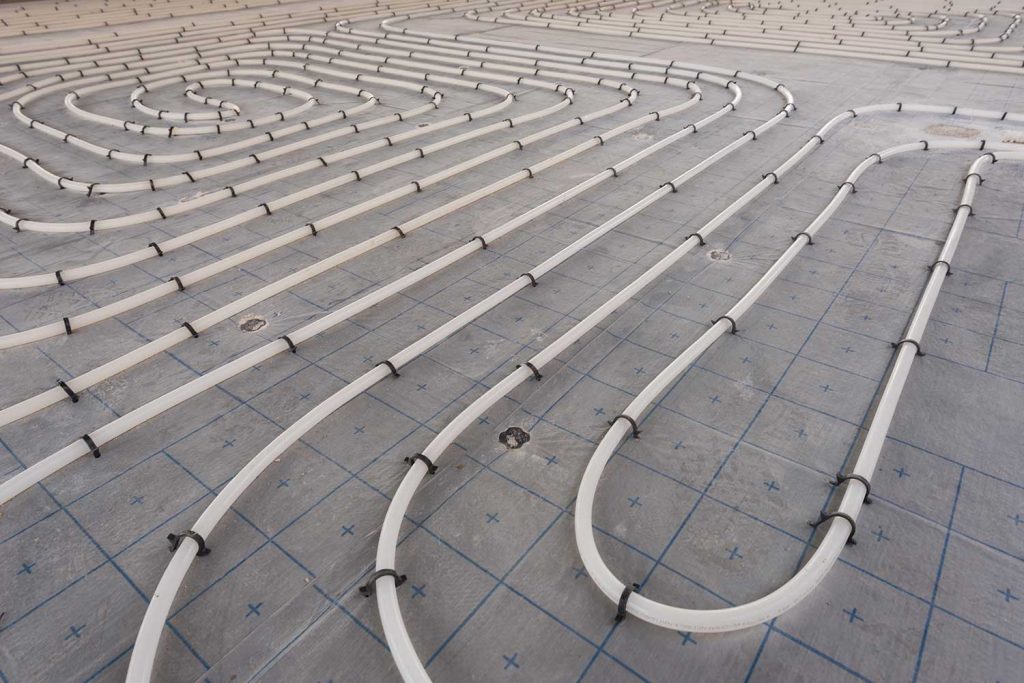An increasing number of homeowners are moving towards radiant flooring systems, as they can offer consistent, even heating, and significant energy savings. However, similar to any type of heating system, there may be times when radiant flooring heating may malfunction. In this post, we'll help you understand the types of issues that can cause your heated floor system to stop working, and what to do when it does.
The types of issues that may prevent electric radiant heating from working will typically differ from those of hydroponic radiant heating systems. Here are the most common issues for each system:
Electric Radiant Heating-
- Tripped circuit breakers
- Damages to the electric mat or wiring
- Thermostat issues
Water Radiant Heating-
- Valves not working
- Tubing problems
- Boiler issues
- Injection pumping
- Change in floor covering
When any heated system stops working it can cause a huge inconvenience and disruption in a household, so it helps to know how to troubleshoot the potential source of the issue. Keep reading to learn more about how these common issues can affect your radiant heating system and what to do about them.

Contents
Troubleshooting Radiant Flooring Issues

Let's take a closer look at how to troubleshoot radiant flooring issues in electric radiant heating and water radiant heating systems.
Electrical Radiant Heating Issues
Here are a few common issues that may cause an electric radiant heat system to stop working:
Tripped Circuit Breakers
Your radiant system can trip your electrical box either as a result of damaged wiring, bad wiring, or the over-consumption of power. Electric floor heating doesn't require a large supply of electrical power; however, your home must have enough electrical power within the box to support your radiant system and prevent your panel from becoming overloaded to the point where it begins to trip your breaker box. Most homes' electrical panels can support around 100 to 200 amps of power.
An incorrect or under-sized breaker will continue to trip until it's replaced with one suitable for the home's power requirements. If you suspect that this is the cause for your radiant heating issues, it's best to have an electrician inspect your system to perform resistance tests and recommend the proper setup.
Damages To The Electric Mat Or The Cables
The electrical mat and cables for radiant heating are designed to be durable and long-lasting. However, they can be exposed to damage from things such as heavy furniture, home renovations, and cracked stone flooring, in which case they will need to be replaced or repaired.
You can determine if your mat or heating cable is functioning properly by using an Ohm-meter to perform resistance checks. These types of checks should be performed at each stage of the radiant flooring installation process, as they help to determine the source of potential electrical issues. If issues such as damaged wires or mats are found during the tests, they can be addressed immediately to prevent further damage and other malfunctions.
Click here to check out this Ohm Meter on Amazon.
Thermostat Issues
A faulty thermostat can also be the reason that causes a radiant flooring system to become inoperable. Sometimes a thermostat may become stuck in the "on" position, in which case, the electrical contacts will stay closed despite the current thermostat settings or desire temperature, and they will continue to provide power to the floor. When this occurs, it's important to immediately turn off all power to the heating system and contact a technician to have the thermostat repaired or replaced.
Hydroponic Radiant Heating Issues
Here are a few common issues that may cause a hydroponic radiant system to stop working:
Mixing Valves/Ports Not Working
If your hydronic radiant system has stopped working or is not getting warm, there may be an issue with your mixing valve. There are three ports on the valve that allow water to flow through at the correct temperatures, which in turn heats a hydroponic flooring system.
If there is an issue with the valve, it may not be able to supply warm water to the flooring system. For example, if the valve is not turning anymore due to rusting or its ports have become clogged with residue or any type of build-up, it will need to be cleaned or replaced.
Tubing Issues
Blocked tubes can also cause a hydroponic flooring system to malfunction. The tubing installed in a hydroponic system can become moldy or rusty over time, especially if it contains cast iron or steel fittings.
When this is the case, flooring technicians will typically swap out these tubes and replace them with SoloRoll, a type of tubing for which mold and mildew can easily be treated by blowing out the tubing with compressed air.
Boiler Issues
Issues with a home's boiler can turn into issues with hydroponic flooring systems. The most common issue is that the system is not providing enough heat. If this is the case, it may be that your boiler is not cycling on and off properly, preventing the system from reaching the desired temperature setting, or that it is simply not big enough to support the system.
If it's the latter, the boiler will need to be upgraded to a bigger model.
Injection Pumping
If a hydroponic radiant system uses injection pumping, issues with the supply and injection pipe sensors can cause it to malfunction. If the outdoor sensor on the pipe is faulty, it will not be able to provide the correct temperature for the water supply, leading to a system shut down as well as low heating issues.
An electrician can check the sensors with an Ohms meter (aka "multimeter") to see if this is causing the issue and if so, they (or the pump itself) will need to be replaced.
Change In Floor Covering
The ideal temperature for the water that heats a hydroponic floor system will vary depending on the type of top flooring used with the system. If the water temperature is too hot or too cold for the type of flooring used, the system can malfunction due to inconsistencies with the thermostat setting and floor maximum temperature capabilities (which can trigger shut-offs in some systems).
When installing new flooring or changing the current flooring, it's important to ensure that the recommended temperature for the home's boiler matches the suitable temperatures for the flooring.
Why Is The Underfloor Heating Patchy?
If an underfloor heating system seems to warm up in only certain areas, it could mean that there are issues with the top flooring or the installation of the system. Below are the most common reasons for this issue:
Cable Spacing
If you find that there are areas of your heated floor system that are warmer than other areas, it may be that your electric heating cable was not spaced correctly when it was installed. Irregularly spaced electrical cables can cause a floor to get warmer above the closer cables but cooler where the cables have more spacing in between them.
If the entire floor feels colder on some days more than others, it could mean that the issue is a lack of insulation in that specific room.
Mismatched Subfloor
A mismatched subfloor can also cause patchy heating with radiant heat systems. If different types of materials are used in different areas of the subfloor, it can create inconsistencies when installing a radiant heat system due to the varied electrical conductivity levels of the materials. In which case, the amount of heat absorbed and lost by the subfloor will affect its surface temperature depending on the area.
Clogged Tubing
Tubing issues can also cause patchy heating with hydroponic systems. Over time, the tubing can become clogged from water scale buildup, causing blockages in the system. Oxygen in the tubes can also cause blockages, as it can corrode tubing seals, plumbing connections, and pumps.
How Do You Reset Underfloor Heating?
Resetting underfloor heating is as simple as resetting any other type of home heating system for the most part. Radiant heat systems usually come with a recommended thermostat that is designed specifically for that system type. The resetting process will vary depending on the thermostat model and radiant system setup. They may also come with a floor sensor option, which is used to prevent the flooring from reaching temperatures that are too high.
The ideal operating temperature for a radiant heating system will vary and mostly depends on the materials used for the top floor and the insulation efficiency of the home or space.
Does Radiant Heat Have A Pilot Light?
Electrical radiant systems do not require a pilot light as they use electric resistance cables and source their energy needs from a home's electrical panel. Hydroponic radiant systems do require a pilot light as they use heated water from a gas boiler to warm the water flowing through the system's tubing. Gas boilers contain a pilot light that is responsible for lighting the gas to heat the water in the boiler.
How Do You Winterize Radiant Floor Heating?
With electrical radiant heating, winterization isn't really necessary, though it's always helpful to ensure that your home has proper insulation during the winter months. Also, if you are planning to be away for an extended period, it's advised that you keep a small stream of water flowing in your faucets to prevent your home's plumbing pipes from bursting.
For hydroponic radiant systems, usually by just keeping the system running in the winter, it will remain in working order (even at a lower thermostat setting). The tubing used for hydroponic radiant systems is designed to be pretty resilient and can withstand cold temperatures.
The hydroponic tubing is flexible and will expand with frozen water as opposed to immediately bursting. However, prolonged exposure to sub-zero temperatures can cause it to burst. This can be avoided by adding a type of antifreeze solution called Propylene Glycol to the system.
Click here to see this Propylene Glycol on Amazon.
It's best to have an HVAC technician who is familiar with this type of system to perform this task for you, as adding the wrong amount can lead to disastrous freezing damage as well as huge issues with your home's plumbing system.
Wrapping Things Up
If you are troubleshooting your radiant flooring system and you find that it's still not working, it's best to call a knowledgeable radiant flooring technician so that they may get your system back up and running safely.
Before you go, be sure to check out our other HVAC posts:


